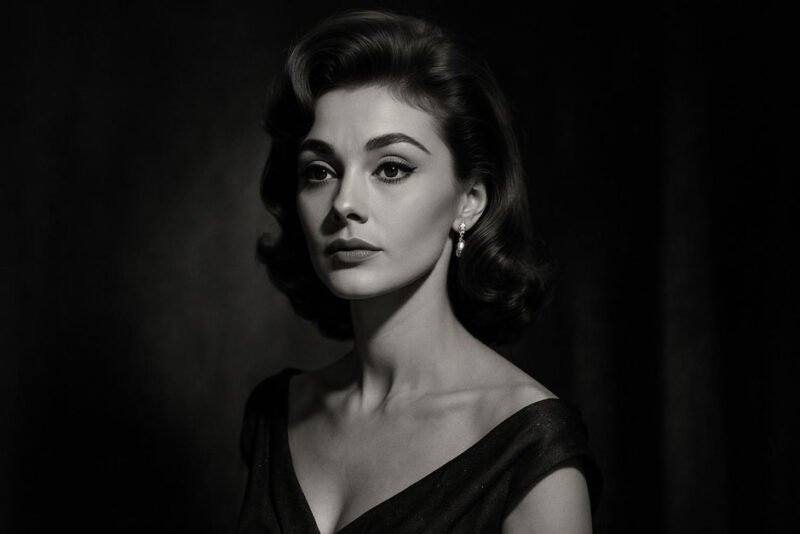Eva Six, originally named Éva Klein when she was born in Budapest in 1937, became a fascinating figure whose life story reads like a compelling blend of personal tragedy and unexpected triumph.
What makes Eva Six’s story particularly compelling is how it breaks away from the typical Hollywood success narrative. Her journey weaves together powerful themes of survival, personal reinvention, and the relentless pursuit of artistic identity. While many of her contemporaries chased fame through any means necessary, Eva Six took a refreshingly different approach to her career, always prioritizing authentic human connection over the manufactured glamour that dominated the industry.
Early Life and Wartime Struggles
Eva Six’s remarkable journey started in Budapest, Hungary, where she entered the world as Éva Klein, born into a family that reflected the cultural diversity of the region. Her father came from a Jewish background, while her mother was a practicing Catholic. This mixed heritage would later prove to be both a source of cultural richness and, tragically, a dangerous liability during the horrific years of World War II.
When the war swept across Europe, it brought devastating changes that would forever alter the Klein family’s trajectory. Eva’s father became one of the countless victims murdered by the Nazis, a heartbreaking tragedy that forced her mother into an impossible situation. The decision to change their family surname wasn’t just a bureaucratic formality but literally a matter of life and death, helping them slip under the radar and avoid further persecution during the Holocaust.
Even amid such overwhelming trauma, young Eva displayed the kind of resilience and natural charisma that would later serve her well in Hollywood. After the war finally ended, she entered and won a local beauty contest, showcasing the magnetic presence and confidence that hinted at her future potential in the entertainment world.
Escape from Hungary and New Beginnings
The year 1956 brought another life-changing moment when the Hungarian Revolution erupted across the country. Eva and her husband Roy Schmidt, who worked as an architect, found themselves actively supporting the Freedom Fighters during this dangerous and uncertain time. When the revolution was ultimately crushed by Soviet forces, the young couple faced an agonizing decision that would completely reshape their future.
In a move that sounds almost cinematic, Eva and Roy used twenty bottles of vodka as bribes to facilitate their dramatic escape from Hungary. They managed to flee to Austria, demonstrating not only their resourcefulness but also their unwavering commitment to freedom and a better life. The journey was undoubtedly perilous, but it represented their best hope for a fresh start away from political oppression and uncertainty.
By 1960, the couple had made their way to the bright lights of Hollywood, though Eva’s initial work was far removed from the entertainment industry she would later join. She spent her early American years running a delicatessen in Los Angeles, a humble but honest occupation that seemed worlds apart from her childhood dreams of performing. This period of ordinary, working-class life would prove to be temporary, as her true calling in the arts continued to pull at her heart.
Hollywood Transformation and Career Launch
Eva’s transformation from small business owner to Hollywood actress began when she caught the discerning eye of James H. Nicholson, who served as president of American International Pictures. Nicholson possessed the kind of industry instinct that could spot star potential, and he immediately recognized something special in this Hungarian immigrant that set her apart from the countless other hopefuls flooding into Hollywood.
The evolution from Eva Klein to Eva Six wasn’t accomplished without some pushback from the actress herself. Nicholson insisted on changing her surname from Klein to Six, a decision that Eva initially resisted because she worried it sounded too much like “sex.” This concern perfectly captured her desire to be taken seriously as a legitimate actress rather than being reduced to merely another sex symbol in an industry already saturated with them.
American International Pictures launched an aggressive marketing campaign, positioning her as the exciting new “Hungarian Sex Bombshell” and drawing deliberate comparisons to already established stars. Industry insiders and entertainment journalists began describing her as possessing “Monroe’s face, Mansfield’s body and Zsa-Zsa’s accent,” a combination that seemed perfectly crafted for 1960s Hollywood’s insatiable appetite for exotic beauty and European sophistication.
Brief but Memorable Film Career
Although Eva Six’s film career was remarkably brief, it managed to leave a lasting impression on everyone who had the opportunity to work with her. Her complete filmography consisted of just three productions, all released during the pivotal year of 1963: “Operation Bikini,” “Beach Party,” and “Four for Texas.” Each of these films provided a different showcase for her screen presence and demonstrated various aspects of her developing acting abilities.
“Operation Bikini” served as her official debut and became the primary reason for her promotional tour to Boston, where she generated significant headlines with her refreshingly thoughtful and intelligent approach to fame and celebrity. “Beach Party” positioned her within the popular beach movie genre that came to define much of 1960s youth culture and entertainment. “Four for Texas” completed her brief but surprisingly impactful career in American cinema.
Despite working on such a limited number of films, Eva Six managed to make a powerful impression on industry professionals who recognized her potential. One experienced press agent noted that while he had witnessed many young women attempt to break into Hollywood over the years, Eva “really knows where she wants to go and she will get there.” A photographer who worked closely with her during various shoots observed that “she’s sure got the equipment,” referring specifically to her natural screen presence and innate understanding of how to work with the camera.
Personal Philosophy and Public Image
What truly distinguished Eva Six from many of her contemporaries in the entertainment industry was her remarkably thoughtful approach to fame and her crystal-clear sense of personal identity. When journalists and interviewers asked about her career goals and aspirations, she consistently responded with the simple but powerful statement: “I just want to be Eva Six.” This response represented her firm rejection of any attempts to mold her into someone else’s predetermined vision of what a star should be.
Her personal philosophy extended well beyond her professional life into her views on relationships and what constituted real success. When television interviewers posed the standard question asking for advice to young women with “stardust in their eyes,” Eva responded with characteristic wisdom and authenticity: “keep their hearts straight, and give a lotta love.” She genuinely believed this approach was the only reliable way they would “get a lotta love” in return from both their careers and their personal relationships.
Eva proved particularly resistant to being typecast as merely another sex symbol in an industry that seemed determined to reduce women to their physical attributes. The very thought of being pigeonholed into such a limiting role genuinely “scared” her, as she much preferred to “make an image as an actress” with real depth and substance. She frequently reminded people, “I’m not really a dumb blonde,” consistently demonstrating her intelligence and emotional depth that extended far beyond surface appearances.
Return to Budapest and Later Life
Following her brief but notable Hollywood career, Eva Six made the deeply personal decision to retire from acting and return to her cultural roots in Hungary. She and her husband Roy Schmidt moved back to Budapest, completing a meaningful full circle that had begun with their dramatic and dangerous escape during the 1956 revolution.
This return to Hungary represented much more than simply a change of geographic location; it symbolized Eva’s profound desire for authenticity and her need to reconnect with her cultural heritage after years of living in the artificial environment of Hollywood. Away from the constant glare of the entertainment industry spotlight, she was finally able to live a more private and peaceful life, focusing her energy on her relationship with her husband and their family.
Eva Six passed away on February 21, 2000, in Hungary, bringing to a close a remarkable life that had literally spanned continents and decades of dramatic historical change. Her devoted husband Roy Schmidt survived her by six years, passing away in 2006. Their enduring partnership had successfully weathered revolution, immigration, brief fame, and all the complex challenges that come with building a meaningful life across multiple countries and cultures.
Legacy and Cultural Impact
Although her film career lasted only one year, Eva Six’s impact on Hollywood and popular culture extended far beyond her brief time in the entertainment spotlight. She represented a unique type of performer who successfully brought European sophistication to American entertainment while never compromising her authentic voice and deeply held personal values.
Her story continues to resonate as a powerful testament to the immigrant experience in America, particularly for those who fled political persecution and rebuilt their lives from scratch. Eva Six demonstrated that meaningful success could be achieved without compromising one’s core identity or fundamental values, a lesson that remains remarkably relevant for performers and immigrants today.
Within the specific context of 1960s cinema, Eva Six occupied a special and important place as an actress who absolutely refused to be defined solely by her physical appearance. Her consistent insistence on being taken seriously as a performer, rather than just another sex symbol, actually prefigured later movements toward more complex and nuanced roles for women in entertainment.
Her enduring legacy lives on as a shining example of grace under pressure, authenticity in an inherently artificial industry, and the courage to choose personal fulfillment over continued fame. Eva Six proved that sometimes the most powerful statement an artist can make is knowing exactly when to step away from the spotlight while maintaining their dignity and principles completely intact.









